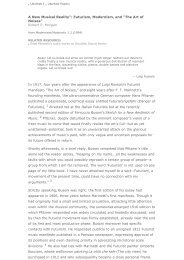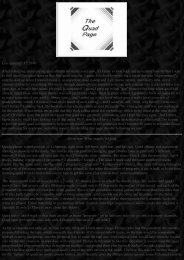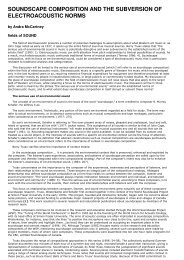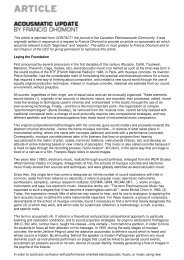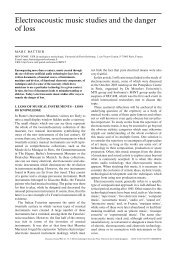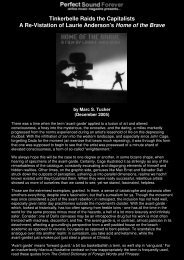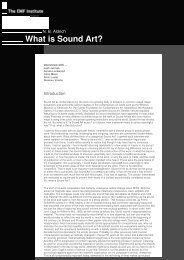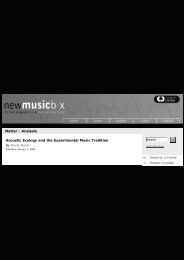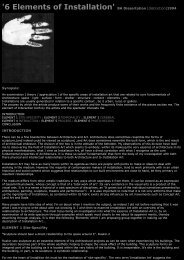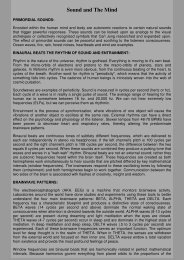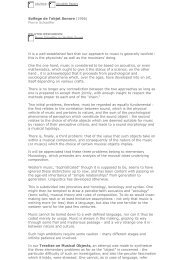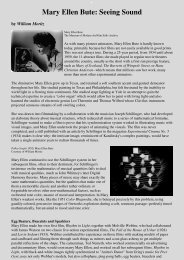Labelle-xxxx-Speaking Volumes.pdf - An International Archive of ...
Labelle-xxxx-Speaking Volumes.pdf - An International Archive of ...
Labelle-xxxx-Speaking Volumes.pdf - An International Archive of ...
- No tags were found...
Create successful ePaper yourself
Turn your PDF publications into a flip-book with our unique Google optimized e-Paper software.
pleasure and/or pain within the social formation <strong>of</strong> either musical fansor their antithesis. From this perspective, music is a site <strong>of</strong> violencethat manifests in the ecstatic joys <strong>of</strong> personal celebration as well asthe cries <strong>of</strong> dislike.Sound too is generative <strong>of</strong> such opposed reactions. When channelledinto the production <strong>of</strong> public art it may be understood as a gift to thedynamics <strong>of</strong> audition, magnetized by its attempt to <strong>of</strong>ten makeapparent an aspect <strong>of</strong> the given environment or site. At timesadopting a relation to found phenomena, such as wind, light, or water,sound art in the public realm <strong>of</strong>ten seeks to further the potential <strong>of</strong>harmony by creating an audible cradle by which new forms <strong>of</strong>attention, perception, and care may be generated. Projects by suchartists as Hildegard Westerkamp, Max Eastley, and William LouisSørensen lend to this potential by allowing the sensitivities <strong>of</strong> the earto find its place.The installation began outside with three introductory panels introducing the subjects <strong>of</strong> listening andsoundscape. As visitors walked towards the Mati Ghar a natural cross-fade occurred from the sounds<strong>of</strong> New Delhi to a composed Indian soundscape broadcast from the loudspeakers on both sides <strong>of</strong> thepathway.Photo by Hildegard WesterkampLeading listener's through a sonic portrait <strong>of</strong> Vancouver,Westerkamp's soundwalks (initially produced in relation to herinvolvement with Vancouver Co-Operative Radio in the1970s)exemplify the artist's desire to make apparent the life <strong>of</strong> environments:compositionally, field recordings taken around the city are interwovenwith fragments <strong>of</strong> narrative about certain locations, leading the ear inand out <strong>of</strong> levels <strong>of</strong> perception and appreciation. Here the microphoneand recording device probe and uncover the life <strong>of</strong> the city in sonicdetail. As Westerkamp states, the functions <strong>of</strong> a soundwalk are"orientation, dialogue and composition."Westercamp's more recent Nada installation, researched andpresented in Delhi with Savinder <strong>An</strong>and, Mona Madan and VeenaSharma, comes to spatialize the soundwalk by structuring thelistening journey through a series <strong>of</strong> rooms and environments:incorporating sounds, textual information, spatial features, andambient details, the installation seeks to question our relation to theenvironment by provoking reflection on the auditory. How does soundmake an impression on our inner-most life, and how does it come tooccupy the borders between health and hazard, balance and itsantithesis? Whereas Westerkamp gains most <strong>of</strong> her sound materialsfrom audio recording, the artist Max Eastley has striven to draw uponthe direct movements <strong>of</strong> natural environments. From his Aeolian harp



